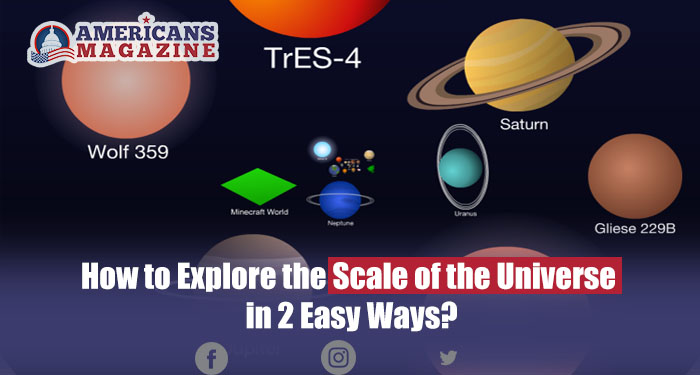Have you ever wondered how big the universe is? How small an atom is? How many galaxies are out there? If you are curious about the scale of the universe, you are not alone. Many people have tried to visualize and understand our reality’s vastness and minuteness. In this article, we will show you two easy ways to explore it using interactive websites that let you zoom in and out of different objects and phenomena.
Scale of the Universe
The first website we recommend is https://scaleofuniverse.com/, created by Cary Huang and remastered by Dave Caruso, Ben Plate, and more. This website allows you to scroll through various sizes, from the Planck length (the smallest possible length in physics) to the observable universe (the largest possible distance we can see).
Along the way, you can click on various objects to learn more about them, such as quarks, viruses, humans, planets, stars, galaxies, and more. You can also toggle the audio on or off to hear some relaxing music and sound effects.
Some of the fun facts you can learn from this website are:
- The smallest thing we can see with a microscope is a bacterium, which is about 1 micrometer (one-millionth of a meter) in size.
- The human eye can see up to 10 kilometers (6 miles) in clear conditions, which is about the same size as Mount Everest.
- The largest living organism is a fungus called Armillaria ostoyae, which covers an area of 9.6 square kilometers (3.7 square miles) in Oregon, USA.
- The diameter of the Sun is close to 1.4 million kilometers (870,000 miles), which is about 109 times larger than the Earth.
- The Milky Way galaxy has roughly 200 billion stars with a diameter of about 100,000 light-years (a light-year is equivalent to the distance light travels in 12 months, which is about 9.5 trillion kilometers or 5.9 trillion miles).
- The radius of the observable universe is close to 46 billion light-years, which means it contains about 93 billion light-years of space. That’s a lot of room for exploration!
The Scale of the Universe 2
The second website we suggest is https://htwins.net/scale2/, created by Cary and Michael Huang. This website is similar to the first one but has some different features and objects to explore.
For example, you can switch between different languages, change the background color, and view some animations and videos. You can also compare the sizes of various objects by dragging them around.
Some of the interesting things you can discover from this website are:
- The smallest unit of information is a bit, which can be 0 or 1. A bit is about 0.2 nanometers (one billionth of a meter) in size, which is smaller than an atom.
- Generally, human hair is about 100 micrometers in diameter, about the same size as a dust mite.
- The Eiffel Tower is about 324 meters (1,063 feet) tall, which is about the same size as a Boeing 747 airplane.
- The largest animal on this planet is the blue whale. The sea animal can weigh up to 190 tonnes (210 tons) and grow up to 33 meters (108 feet) long.
- The largest star in the galaxy is UY Scuti, which has a radius of about 1.7 billion kilometers (1.1 billion miles), which is about 1,200 times larger than the Sun.
- The largest known structure in the universe is the Hercules-Corona Borealis Great Wall, a cluster of galaxies that has roughly 10 billion light-years across.
Our Latest Article: Experience Zero Gravity Fun with Google Gravity in Your Browser
FAQs
Q1: What is the scale of the universe?
A: It’s a way of measuring and comparing the sizes and distances of different objects and phenomena in our reality. It ranges from the smallest possible length in physics (the Planck length) to the largest possible distance we can see (the observable universe).
Q2: Why is it important to learn about the scale of the universe?
A: Learning about it can help us appreciate the diversity and complexity of our existence. It can also inspire us to ask more questions and seek more knowledge about our world and beyond.
Q3: How can I explore the scale of the universe?
A: One easy way to explore it is to use interactive websites that let you zoom in and out of different objects and phenomena.
Q4: What are some challenges or limitations of exploring the scale of the universe?
A: Some challenges or limitations of exploring it are:
- The scale of the universe is constantly changing as new discoveries are made, and measurements are taken.
- It is based on our current understanding and observation of reality, which may be incomplete or inaccurate.
- It is hard to comprehend and visualize, as our human senses and intuition are not adapted to deal with such extreme sizes and distances.
- Depending on their frame of reference, speed, and gravity, the platform may not be the same for different observers.
Conclusion
If you want to explore more, we encourage you to visit the websites we mentioned and have fun zooming in and out of reality. Remember, the universe is a big place but also full of wonders. Happy exploring!
Checkout Related Article: Learn to Survive and Thrive with the Zerg Rush on Google













